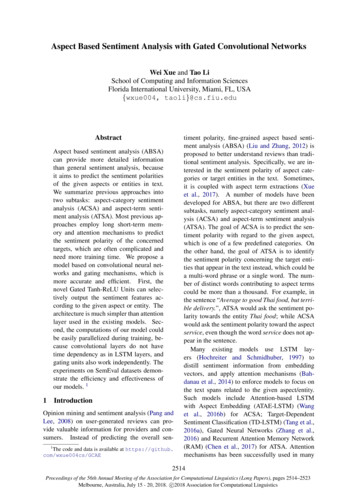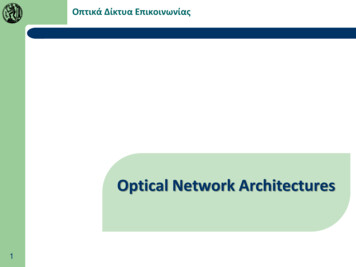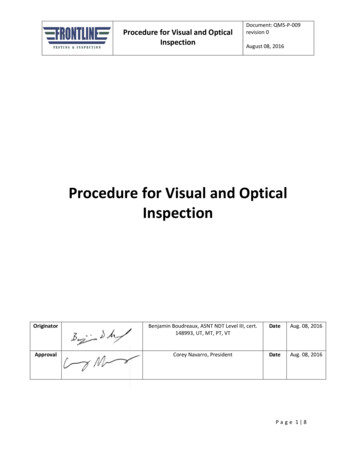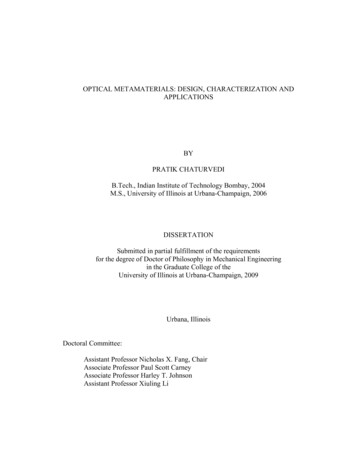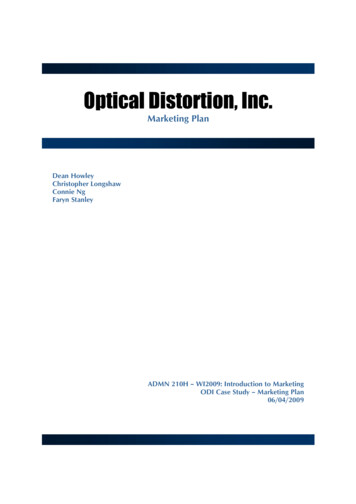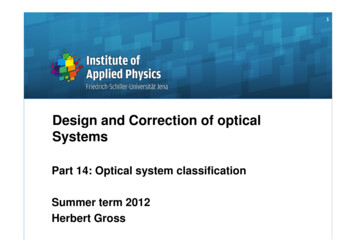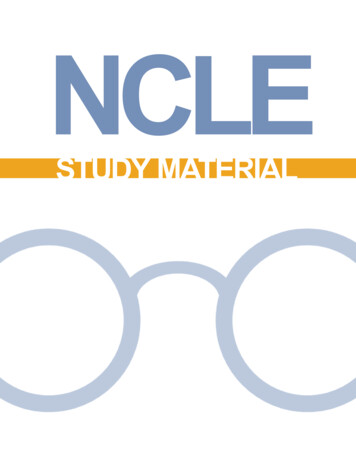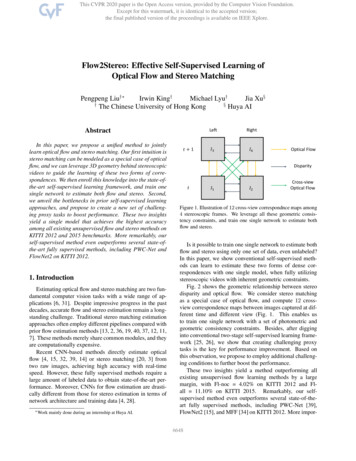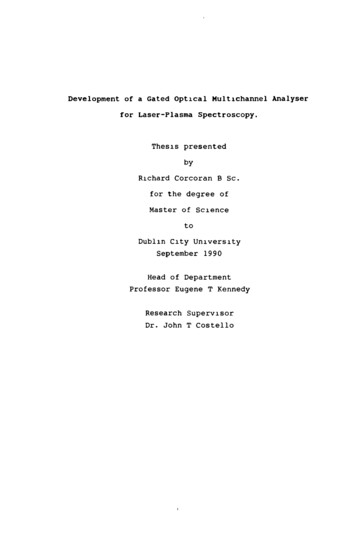
Transcription
Development of a Gated Optical Multichannel Analyserfor Laser-Plasma Spectroscopy.Thesis presentedbyRichard Corcoran B Sc.for the degree ofMaster of SciencetoDublin City UniversitySeptember 1990Head of DepartmentProfessor Eugene T KennedyResearch SupervisorDr. John T Costello
serdetectionlaser-produced plasmas(LPPs)of(OMA)hasradiationbeenfromThe system is based on agated image - intensified photodiode array (PDA)Softwarefor the controlthe OMAof,and data acquisitionsystem has been developedfrom,A high resolution (10ns) delaygenerator was also designed and constructed to permit timeresolved optical spectroscopy The system has been testedand operated with a laser plasma source m the visible andnear infra-red (NIR) spectral region (400 - 800nm)Some initial results from preliminary experiments toextend the usefulness of the OMA system into the vacuum-UV(VUV) are presented1
ACKNOWLEDGEMENTSI wish to thank first and foremost my supervisor ncouragement throughout all aspects of the work containedin this thesis. I would like to mention, in particular, hisfriendliness, easy manner and his willingness to help outat all timesI shall remain gratefulI would also like to thank the other members of theLaser-PlasmagroupatD C U ,namelyProf.EugeneTKennedy, DrJean-Paul Mosnier and DrJames Brilly fortheir support - in matters physical and earthly - during mytime here.I also wish tothankthe membersofthe technicalstaff for all their help, in particular Mr. A1Devine forthe prints contained in this thesis and Mr. Alan Hughes forhis thoughts in relation to BBC programming and electronicdesign.I would also like to express my thanks to ofTechnology, Kevin Street and to the City of Dublin V E.C.for their employment over the last two years, without whichI could not have survived financiallyFinally,I would like to thank my family for theirsupport throughout this work11
CONTENTSPageAbstracti11AcknowledgementsChapter IIntroduction11.1Overview1I 2Formation of a Laser-Plasma31.3Properties and Diagnostics ofLaser-Produced Plasmas5I 4I 5Applications of Laser-Produced PlasmasDevelopment of Multichannel Detectors1.6Photodiode Arrays (PDAs)1.7MicroChannel Plate Image Intensifîers12(MCPs)Chapter II6813Development and Testing of the OMASystem15\i11.1The Optical Multichannel Analyser(OMA)II 2The Camera HeadII 3The ITT MicroChannel Plate Image1516Intensifier (MCP)20II 4The Delay Generator22II.5II. 6The Detector Controller/InterfaceBBC/OMA Software Package2427II 7OMA System Performance32Chapter IIIExtension of the OMA systeminto the VUV47III 1 Introduction47III.2 VUV OMA configuration48III.3 Scintillators and Phosphors49III 5 System Resolution - Edge Test55i n
PageTungsten Continuum Spectrum atcaChapter IV1500Â60Summary, Conclusions and Future Work63IV 1Summary/Conelusions63IV.2Future Work63ReferencesAppendix IAppendix II65BBC/OMA Program ListingsProgram "MENU1"1-1Program "OMAl"1-3Program "MONITOR"Program "GETDAT"1-81 -1 1Program "PLOT"1-15Program "PRNTERl"1-20Program "PRNTER2"1-23Program "PARAM"1-26Program "DATADSB"1-27Program "DATLOAD"1-29Program "DUMP"1-30Program "CAT"1-33Program "FILCON"Program "FILADSB"1-341-35Program "FILDIV"1-36Program "FILSMO"Program "STEPPER"Program "DSCOPE"Program "DSCOPEl"1-371-381-391-41Specifications of the Model4145-2 Digital ProgrammableTime Delay ModuleII-lSpecifications of the ITTMicroChannel Plate ImageIntensifierII-2Photograph of the ExperimentalIV
PageSet-up for Testing theIntensified PDAAppendix IIIUnrelated WorkvII-3
CHAPTER IINTRODUCTION1.1 cused onto a solid target in vacuo , a short lived, hightemperature / high density plasma is formedplasma parameters, e gAs many of theelectron temperature, dominant ionstage etc., are to some extent controllable, the study rstanding of the basic physics of hot, ionized matterTo date, these studies have involved the analysis of bothradiative (IR to X-ray) and particle (neutral species, ionsand electrons) losses from the expanding plasma. Indeedlaser- produced plasmas have proven to be versatile sourcesin atomic spectroscopy for the study of the emission andabsorption of light by ions in low, medium and high stagesof ionisation.The development of laser-plasma spectroscopy has beenassistedinnosmallinstrumentation, mwaybydevelopmentsinparticular by progress in multichanneloptical detectors which are capable of recording a completespectralrecordingslice as opposed to traditional point by pointwithmonochromators.described baseddetectorisWith the advent of very high power lasers, capable ofproducing focused irradiances in excess of 1017 W/cm2, ithas become possible to generate plasmas which exhibit uction of anomalously high energy X-rays, electrons andions, neutron emission, the generation of harmonics of theincident laser wavelength and magnetic field generation atthe megagausslevel,all of whicharisefromtheplasma-laser light interaction1(see Schwartz et al eds ) ,
I1981, for a erresearchthepastintothisparticular class of plasma has been primarily motivatedthe possibility of attaining the density,confinement ndnuclearIn recent years, although research on laser-inducedplasmas has continuedtoconcentratethere has been a growing interest inonthebasicphysics,applicationsoflaser-produced lications of laser-produced plasmas are briefly outlinedin sections I 2, I 3 and I 4.2
1.2 Formation of a irradiated surface differ for the cases of conductors andinsulators. As only metal targets were used in this work,the laser-light/surface interactions for these targets willbe briefly discussed. Although the laser field penetrates h, it couples so strongly to the conductionelectrons that heating, evaporation and ionization rapidlyoccurbyThe r.m.s. E-field is related to the laser flux (0)theexpressionE*2X109V/m,whichE 19.401/2,soforis of the order of 0.1%0 lOl2W/cm2,ofthefieldexperienced by an electron located one Bohr radius from ahydrogen nucleusThe net effect of this laser interactionis to produce a thinlayer of cool,close to the target surfacelow density plasmaThis diffuse plasma is formedwithin the first few optical periods of the laser pulse ction process (Fig.l 1).In the growth phase of the plasma, laser radiation isabsorbed by the priming plasmainversebremsstrahlungincoming laser light,Asthrough the mechanism oftheelectronsabsorbtheir kinetic energy increasestheandthey produce further ionization through collisions withatoms and ions in the plasmaAs the plasma electrondensity(ne) increases,the proportion ofradiationabsorbed increases, which in turn increases the electrondensity and so onabsorptionThiscoefficientinterplay between the radiationandtheplasmaelectrondensityresults man avalanche-like ionization process whichrapidly drives n towards the critical value (n ) across aeclayer close, to the target face. At this 'critical densitysurface' the incident light is reflected back towards thelaser source while in the layers just in front of it n n . Once the critical density layer (or deflagration zone)is established,laser radiation can no longer reach3the
targetsurfacetogeneratenewplasmaevaporation and tbyhotfurtherplasmaiswithasurfaceconsequent decrease in electron density so thatthelaserradiation may once again reach the target. For laser pulsesof 100 picoseconds duration or greater,plasma generation,heatingsingle, smooth intothroughoutofatheextent of the optical pulseFurther detail on the generation ofgiven mlaser-plasmasthe paper by Carroll and Kennedy (1981)H 0#ovty PlasmoFrontLow 0«nsityBtowoffPI asmaFig.1.1. Microscopic representation of alaser-plasma source.4is
1.3 Properties and Diagnostics of Laser-Produced Plasmas.There are a number of questions concerning laserproduced plasmas which one might conceivably ask How doesthe plasma grow and decay in time7 What is the electrontemperature and the electron density and how do they varyin space and time? What ionic species are present in theplasma? Many of these questions are readily answered by astudy of the radiation losses from laser-produced plasmas.The electron temperature of a plasma may be obtainedfrom a measurement of the slope of the photoionisationcontinuum which varies as e hc/*k(Te) (Qalanti and Peacock/1975)For plasmas m local thermodynamic equilibrium, T may be determined by measuring line intensity ratios ofhighlylyingresonanceelectron density (njspectroscopically.lines(Boikoetal,1983)Theof a plasma may also be determinedMalvezzietal(1975)usedStarkbroadening of resonance lines in a Be plasma to map thespatial electron density variation up to 2mm away from thedeflagration zone.Line(resonanceintensityratios,inparticular/ intercombination), areusedthea-ratioextensivelyindetermining n for a plasma (Ilyukhin et al, 1981).Sincetherecombinationplasma depends on n ncZ i(nZ lcontinuumintensityina ion density in charge statez , a measurement of the recombination continuum intensityratio can be used to determine the relative abundances ofions in different charge states (Malvezzi et al, 1979).A comprehensive review of spectroscopic diagnostics oflaser-produced plasmas up to 1983 has been published byDeMichelis and Mattioli (1984).5
1.4 Applications of Laser-Produced Plasmas.In recent years there has been an increasing level ofresearch activity into the applications of laser-producedplasmas. These plasmasareexcellentsourcesof XUV/VUVline and continuous radiation and have hence become popularsources for emission and absorption spectroscopy at shortwavelengths. The excellent shot to shot reproducibility zation of laser-produced plasmas with a view tousing them as XUV/VUV radiometric standards (O'Sullivan etal,1 981,1982,Fischeretal,1984).TheintenseXUVradiation emitted from laser-plasmas makes them suitablesources for high-resolution lithographic work (Nagel et al,1978,al,1 9 84,1986)Nagel,1985,Yaakobi et al, 1 9 8 3 ,O'Neill etLaser-produced plasmas have also been used asX-ray/XUV light sources in microscopy (Rosser et al, 1 9 8 5 ,Michette et al,1986)and Extended X-ray Absorption FineStructure (EXAFS) studies.For many years,research into the physics of laser-produced plasmas has been primarily motivated by the fusionprogram (Mallozzi et al,inertialconfinement1981,fusionEason et al,(ICF)record slow but steady progressclean power tinuetothe development of alaseractionatXUVwavelengths has been obtained by workers at a number uced plasmas as short wavelength gain media is amost exciting development and, combined with XUV multilayermirrors of good reflectivityproduce a highly versatile1986,(Barbeesource of1990),coherentshouldradiationwith many conventional and new applications in science andtechnology,eg,XUV(Matthews et al, 1 9 8 5 ,1987).holographyandSuckewer et al, 1 9 8 5 ,interferometryJaegle et al,Central to the development of laser-plasma sources has6
been the study of radiation losses in a range of spectralregions with a variety of detectors. A brief discussion onsome of the different types of detectors will be given mthe next section.7
1.5 Development of Multichannel Detectors.As mostlightsourcesradiateenergy overalargespectral range, studies of such sources require detectionsystemswhich arecapableofquantifyingthe amountlight emitted over an extensive wavelength rangeofThesemeasurements require a spectral dispersing device, such asa grating or prism spectrometer with a light detector.Typical light detectors are photographic film / platesand single-channel electronic detectors, e.g., photodiodesor t incident on them within their spectral responserangesA variety of photographic plates are availablewhich cover the electromagnetic spectrum from X-rays to IRwavelengths. PM-tubes are sensitive in the 250nm to l,100nmrange while photodiodes are available with sensitivitiesfrom X-rays to mid infra-red (-» 12um)Both detector types,haveadvantagesphotographic and nts. Photographic film and plates have tialresolution. A major advantage of photographic detection isits ability to record entire spectra simultaneously, nformationoutinaButstoredcumbersomeadditional step (densitometry, etc.).Monochromators equipped with PMTs and other singlepixel photodetectors provide spectral information on only asingle wavelength ornarrowspectralregion atanyoneinstant. Therefore, measurement of broad spectral regionsgenerally requires wavelength scanning m which light fromdifferent spectral regions sequentially illuminate thedetector. Hence variations in source intensity during thescanning time can lead to erroneousdata.However,PMTspossess fast response time, high sensitivity and linearity;desirable features of any spectrometric detectorYet another spectral analyser is the Optical Multi-8
channel Analyser (OMA)This device is a modular electro-optical signal-processing system for the quantisation oflight intensity as a function of space or (with adispersivedevice)wavelength.Inoperation,dispe
I would also like to express my thanks to Dr Matthew Hussey, Head of the Physics Department, College of Technology, Kevin Street and to the City of Dublin V E.C. for their employment over the last two years, without which I could not have survived financially Finally, I would like to thank my family for their support throughout this work 11. CONTENTS Page Abstract i Acknowledgements 11 Chapter .
